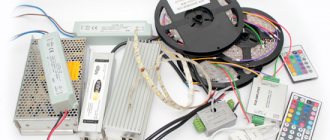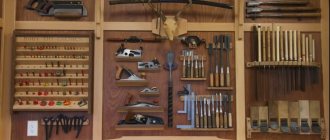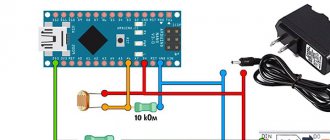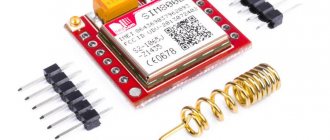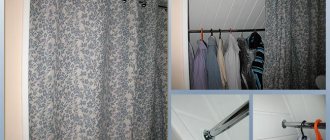Hello dear readers of the construction blog stroidea.ru! In this article you will learn what LEDs are, what advantages and disadvantages LEDs have compared to conventional incandescent and fluorescent lamps, where LED lamps are used, how to calculate the number of LEDs to illuminate a room, and most importantly, how to make LED lighting with your own hands yourself in the apartment?
What is an LED? An LED is a semiconductor element that converts the electric current passing through it into light radiation.
Sober calculation is the basis of success ↑
Selection of power supply for LED strip ↑
LED strips are produced in rolls 5 m long; from 30 to 120 LEDs can be installed in each meter. It is not necessary to use all five meters. If you plan to highlight a smaller area, you can cut it to the required length. As long as you can’t cut anywhere, of course. The cutting frequency should be 3 LEDs; most often, possible cutting locations are indicated by the manufacturer.
LED strips cannot be connected directly to the network, only to the power supply. To select a power source of the required power, you need to know the total power consumption of the entire tape used.
Here's an example of a calculation:
We purchased SMD 3528 tape. Its length is 5 m, the operating voltage is 12 V, the number of LEDs per meter is 60, and the power consumption is 4.8 W/m. In other words, every meter of our tape consumes 4.8 W. All these parameters are indicated on the tape or packaging itself.
The length of the area that we want to illuminate is 7 m. This means that one tape is missing. We buy another cassette 5 m long and cut off the 2 m that we need from it.
Tape power consumption: Ptot = Pm * L = 4.8 W/m * 7 m = 33.6 W;
Where,
Ptotal – total power consumption of the entire tape;
Pm – power consumption of one meter of tape;
L – tape length.
In total, the total power consumption of the tape was 33.6 W. But to ensure proper operation of the power supply, it is necessary to make a power reserve of 20%.
P = Ptot * kz = 33.6 W * 1.2 = 40.32 W;
Where,
P – required power of the power supply;
kз – safety factor (20% in this case).
Now, according to the catalog of power supplies for LED strips, you need to choose one whose power is close to 40.32 W, but not lower.
Calculation of the number of LED lamps ↑
LED lamps can be used in suspended ceilings.
LEDs are no longer used only as decorative lighting. New technologies for the production of high-power LEDs make it possible to use them as head lighting in a house or apartment, and even in production.
The calculation of LED lighting in this case is made taking into account SNiPs, SanPiNs and other regulatory documents in order to ensure comfortable living conditions, life activities or work processes in the room.
To calculate the number of LED lamps and illumination distribution, you can use special programs that are freely available for downloading on the Internet, for example, DIALux.
If exact data is not needed, you can try to make the calculations yourself - in a semi-experimental way. First, we decide what we want to illuminate, and instead of which existing lamps we will use LED ones. Each task will require different lamps: be it floor lighting, head lighting in a room, furniture lighting or suspended ceiling lighting.
For calculations we need only one parameter - luminous flux. This is a kind of brightness, the intensity of light, measured in lumens (Lm). The manufacturer must indicate the luminous flux value on its products, including LED lamps. We will do the calculation based on the fact that a 100 W incandescent lamp shines at approximately 1200 - 1300 lm. For example, to replace a 60 W light bulb in a toilet, you will need to find an LED lamp with a light output of 600 - 700 Lm.
If the information on the packaging is not enough, you can perform calculations based on the power of the lamp. Most often, LED lamps consume from 5 W to 12 W. In this case, the approximate luminous flux per 1 W is 50 – 80 Lm. There may be more, but we will take at least 50. To illuminate a room with an area of 18 m2, 2500 Lm are needed. We divide by the minimum possible luminous flux of 50 Lm per 1 W. We get 50 W. This is exactly what the total power of LED lighting in the room should be. But how to choose: 10 lamps of 5 W each, scattered evenly throughout the room, or 4 powerful lamps of 12 W each - it’s up to you to decide.
LED lighting design ↑
It is better to entrust such an important aspect as design to professionals. And not only because this is their daily bread, but because they will have to face a number of difficulties. The design of electrical wiring and lighting of a house or apartment does not need to be changed, because the load on the network will not increase, but decrease. The complexity of designing LED lighting is related to the technical and optical characteristics of LEDs. For example, light reflection, light emission angle, operating temperature, luminous flux are extremely important, and nuances such as the color of walls and ceilings can radically affect the comfort of lighting.
We install it ourselves ↑
Installation and connection of LED strip ↑
We decide how long the area we want to illuminate with tape. If it is more than 5 m, we buy the required number of cassettes and cut off the missing section. With one power supply you can use a maximum of 15 m of tape (3 cassettes).
Then solder the wires between the segments. We put contact tips on the ends of the wires to improve the quality of contact between the wire and the power supply. We insulate the wires using heat shrink tubing.
Glue the tape to the surface. To do this, remove the protective coating from the self-adhesive side and apply it to the base.
All that remains is to connect it to the power supply. And here several nuances arise:
1. If the power of the power source for the LED strip is not too high, you can connect it without any questions and hide it in the structure so that it is not visible.
Scheme: Connecting two LED strips with two power supplies
2. If we use a powerful tape of great length, for example, 10 m, a 100 W power supply is needed for it. It is very heavy and cannot be hidden in a suspended ceiling. Therefore, it would be more expedient to use two units of lower power for two tapes.
Scheme: Parallel connection of two tapes to one power supply
3. If the length of the tape is large (10 m), and the power of the power supply is not too high, you can connect two tapes in parallel. This method has a number of advantages. The fact is that when current passes through a strip 10 m long, the first LEDs will always overheat too much, and the last ones, on the contrary, will not warm up enough and, accordingly, will shine weakly. To avoid this, it is advisable to connect it in parallel to the power supply.
Scheme: Connecting a color RBG LED strip via a controller
To connect a color LED strip, it is necessary to use a controller. It allows you to change colors, brightness and implements synchronous turning off and turning on of LEDs.
The controller has two terminals: the first is for connecting to the power supply, and the second is for color channels and the common wire. We connect the wires of the power supply to the controller, then connect the tape to the latter.
If you connect two color tapes in parallel, you will need to purchase a more powerful power supply and controller. Unfortunately, they are also too heavy to be installed in a suspended ceiling.
Installation of LED lamp ↑
Installation of an LED lamp does not require any special knowledge or actions. Almost all LED lamps are produced with standard sockets, which makes choosing a lamp much easier.
Such lamps can be mounted on any surface. In any case, that's what the manufacturer says. Consider the option of installing a lamp in a plasterboard partition.
We choose a place for installation. We drill a hole with a drill. We take the lamp, pull its wires into the hole, lightly press the device to fix it.
We insert the required lamp into the lamp. We connect the connectors to the distribution block and connect the power.
Difficulty #2. Lack of normal connectors
I want to “make you happy”, but for the last year, all the tape, with very rare exceptions, has been sold in this form (by the way, it used to come with a special plug)
How to install an LED strip with your own hands?
Only 4 short and thin wires, weakly soldered to the tape. During installation (especially in such hard-to-reach places as a ceiling niche), the wires will begin to break off, and the contacts in the clamps on the controller will work only once in a while. Below is what a normal contact should look like.
The installation of electrical circuits must be approached responsibly
If you remove the old wires and solder new ones, and then put special crimps on them to improve contacts, then the assembly of the LED strip is greatly simplified and becomes an order of magnitude better and more reliable.
The soldering area must be reinforced and protected with heat shrink tube
After soldering, it is best to insulate the contacts with a special heat-shrink tube. This will strengthen the fastening of the wires and prevent short circuits. In principle, this is easy to do, if not for one “but”.
Versatility and variability of application ↑
LED strip lighting ↑
LED strip can be used to illuminate suspended ceilings and other indoor structures
LED strips are not yet used as the main lighting in the apartment; nevertheless, their power is not high enough. But to illuminate the work surface in the kitchen, mark key places in the interior, decorative niches or decorate multi-level ceilings - these are tasks just for LED strips. Due to their flexibility, they can be laid on curved surfaces of almost any configuration.
LED ceiling lighting ↑
LED strips and lamps can be used to illuminate the ceiling
To illuminate the ceiling, you can use both strips and LED lamps. The only difference is that the tape can only provide a decorative function, while lamps can significantly illuminate the room or even serve as the main source of light.
The tapes are glued in the niche of the suspended ceiling so that they are not visible to the naked eye, and are directed upward to illuminate the surface of the ceiling. Lamps are most often mounted in plasterboard suspended ceilings or Armstrong-type structures and directed down into the space of the room.
Room lighting options ↑
You can also use LED equipment for head lighting of the room.
To illuminate the room, LED lamps with lamps from 5 to 12 W are used. How to calculate the required number of lamps and the luminous flux of each has already been described above. At the same time, there are lamps that are designed to replace old incandescent lamps. Lamps can be installed both in chandeliers, sconces, and in furniture frames.
LED lighting in the kitchen ↑
LED lighting in the kitchen: illumination of cabinets outside and inside, as well as the ceiling
Using LED equipment, you can illuminate the work area in the kitchen and places where people are most often found. To do this, you can use lamps built into suspended ceilings. And to illuminate kitchen cabinets, you can use LED strip glued to the surface. If lighting is thought out at the design stage, then, if desired, you can immediately order a kitchen set with places for lamps. Moreover, the cabinets can be illuminated from the inside. For example, make sure that the backlight turns on only when the door is opened and turns off when closed.
LEDs in emergency systems ↑
LED equipment is used in emergency and emergency lighting
Emergency or emergency lighting is designed to illuminate rooms, buildings, vehicles if there is a sudden power outage. In this case, it runs on a generator. The power of LED lighting is so low that it can significantly save the budget of municipal enterprises that require round-the-clock emergency lighting.
Industrial LED lighting ↑
Industrial LED lighting is used in factories, parking lots, highways and other places
The use of LED equipment in industrial and industrial premises allows not only to save on energy consumption, but also provides numerous conveniences. Firstly, if an incandescent lamp fails, you have to call a specialist and equipment to dismantle it or install a new one, since they are at an inaccessible height. If LED lamps are used and their service life is at least 5 years, the need for replacement arises extremely rarely. In addition to indoors, such lamps are used to illuminate embankments, parking lots, cottage villages, highways and roads.
LED lighting is only gaining momentum. It has a lot of advantages: cost-effectiveness, environmental friendliness, convenient emission spectrum, durability, light is visible at a long distance, and, of course, design. In addition, replacing and installing LED lighting is extremely simple; you can do it yourself, without the help of specialists.
LED lamps: pros and cons
LED lighting is gaining increasing popularity today. And this is obvious because:
- LED lighting is currently the most energy efficient lighting;
- LEDs do not contain harmful substances, like fluorescent lamps, so their disposal is simplified;
- LED lamps work much longer than incandescent lamps and energy-saving lamps, about 11 years of continuous operation. This applies only to high-quality LEDs. Low-quality and cheap LED lamps will work for no more than two months and will burn out;
- Ability to adjust lighting intensity and change LED color;
- Due to the fact that the LED has no breakable parts, it is resistant to vibrations and shocks;
- The brightness of the LED depends on the current, and not on the voltage, like with conventional incandescent lamps, so when the voltage in the apartment changes, the LED will not blink like an incandescent lamp blinks.
- The LED does not emit infrared and ultraviolet rays. And, as you know, ultraviolet rays contribute to the fading of furniture upholstery and paint.
LED lamps have only one drawback - their high cost, compared to the cost of incandescent lamps and fluorescent lamps. The cost of high-quality LED lamps with a power of 3-4 W starts from 300-400 rubles; anything cheaper is a low-quality lamp. Some examples of powerful LED lamps reach 4000-5000 rubles.
